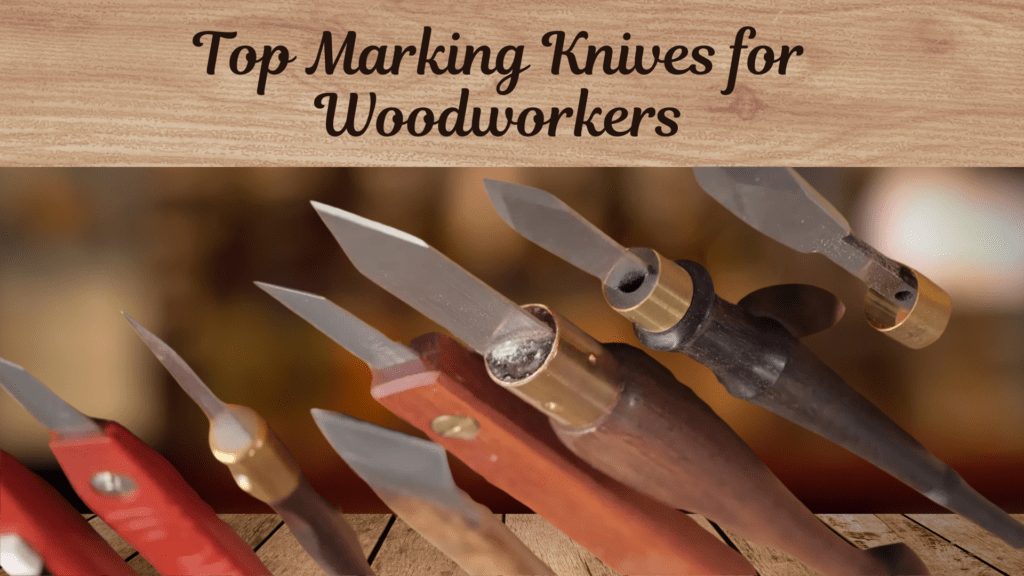
In woodworking, small details matter a lot. Even a tiny mistake can cause big problems later. That’s why a marking knife is such an important tool. But what makes a good marking knife, and why is it so useful?
A marking knife helps woodworkers draw very accurate lines on wood. These lines guide them when they cut, chisel, or join pieces together. Being exact is very important in woodworking, and a marking knife can help make clean, perfect cuts instead of messy ones. Let’s look at what makes a great marking knife and how to pick the right one for you.
Why Every Woodworker Needs a Marking Knife
A marking knife is the best tool for drawing thin, sharp lines on wood. Pencils leave thicker, unclear lines, but a marking knife slices the wood slightly to make a very fine and clear line. This is especially helpful when doing detailed work like dovetail joints, where even a small mistake is easy to see.
The line made by the knife also works as a guide. Tools like saws, chisels, and routers can sit right in the groove, helping you cut exactly where you need to.
Key benefits of marking knives:
- Produce the thinnest, most accurate layout lines
- Prevent tear-out and splintering at the cut edge
- Create a physical guide for hand tools and power tools
- Enable flawless joinery and repeatable results
Anatomy of a Marking Knife
A typical marking knife has a rigid, sharp blade—often made from tool steel—designed to score wood fibers cleanly. The blade may be:
Single-bevel: One side flat, one side beveled. Ideal for working right up against a straightedge or square, with the flat side against the guide for maximum accuracy.
Double-bevel: Both sides beveled, forming a spear or chisel point. More versatile (usable in either hand), but can be less precise when referencing a guide.
Handles are usually wood or composite, shaped for a pencil-like grip for control and comfort. Some knives feature ergonomic or octagonal handles to prevent rolling on the bench.
Types of Marking Knives
Traditional Western Marking Knives
- Spear-point or skewed blades
- Single or double bevel
- Common brands: Narex, Veritas, Blue Spruce, Crown
Japanese Kiridashi
- Single-bevel, chisel-like form
- Exceptionally sharp, hard steel
- Known for versatility: can mark, carve, and pare wood
Craft and Utility Knives
- Replaceable blades (e.g., Swann Morton, X-Acto)
- Affordable and easy to maintain
- Good for beginners or those who prefer not to sharpen
Custom and Premium Knives
- Hand-forged, often with Damascus or high-carbon steel
- Unique handle materials and craftsmanship (e.g., Blacktail Studio Damascus knife)
- Higher price point, collector appeal
What Makes the Best Marking Knife ?
1. Blade Quality and Sharpness
A good marking knife must have a blade that holds a keen edge, resists flexing, and scores clean, deep lines. High-carbon tool steel, Japanese white or blue steel, and Damascus steel are all excellent choices.
2. Tip and Blade Thickness
A thin, rigid blade fits into tight spaces (like dovetails) and leaves precise lines. Too thick, and it won’t reach into fine joints; too thin, and it may flex or break.
3. Bevel Type
Single-bevel knives are best for accuracy against a straightedge, while double-bevel knives are more versatile but slightly less precise for layout work.
4. Handle Comfort and Control
A marking knife should feel like an extension of your hand. Pencil-style grips, ergonomic shapes, and non-slip finishes all contribute to accuracy and ease of use.
5. Ease of Sharpening
A marking knife is only as good as its edge. Look for knives that are easy to hone and maintain, with accessible bevels and durable steel.
Top Marking Knives for Woodworkers

Here’s a curated selection of highly regarded marking knives, each with its own strengths:
| Knife/Brand | Blade Material | Bevel Type | Best For | Notable Features |
| Narex Dual Double Bevel | Mn-V/Cr-Mn Steel | Double | General layout, dovetails | Affordable, robust, ambidextrous2 |
| Blue Spruce Small Marking Knife | Tool Steel | Single | Hand-cut dovetails | Ultra-thin blade, perfect for fine joinery |
| Japanese Kiridashi | Japanese Carbon | Single | Precision, carving, versatility | Multi-use, easy to sharpen, durable6 |
| Swann Morton Dovetail Knife | Carbon Steel | Double | Craft, model making | Replaceable blades, surgical sharpness |
| Blacktail Studio Damascus | Damascus Steel | Double | Premium, collectors | 81 layers, 62 HRC, artisan-crafted3 |
| Veritas Striking Knife | Tool Steel | Single | All-around joinery | Comfortable handle, easy to sharpen |
| MKC 3-Piece Wood Handle Set | Tool Steel | Double | Versatility, comfort | Multiple blade shapes, ergonomic handles |
Also read:
How to Choose the Best Mallet: The Ultimate Guide
Wood Putty or Wood Filler? Stop Making the Wrong Choice!
How to Use a Marking Knife for Best Results
- Hold the knife like a pencil for control.
- Place the flat side against your straightedge (for single-bevel knives) to ensure the line is right up against your guide.
- Make several light passes rather than one heavy cut to prevent wandering and ensure a clean, deep line.
- Use the knife line as a physical reference for chisels or saws—set your tool right in the groove for perfect cuts.
- Sharpen regularly: Hone your knife on water stones or fine diamond plates to maintain a razor edge.
Common Mistakes and Tips
- Don’t use flexible blades (like razor blades)—they can flex and break, leading to inaccurate lines and safety hazards.
- Avoid using craft knives with inconsistent bevels for precision joinery.
- For intricate curves or patterns, use a sharp pencil first, then refine with a knife if needed.
- Keep your marking knife dedicated—don’t use it for prying, carving, or utility work to preserve the edge.
Final Words: Which Marking Knife Is Best ?
The best woodworking marking knife is the one that fits your hand, your work style, and your joinery needs. For most woodworkers, a high-quality single-bevel knife (like the Blue Spruce or a Japanese Kiridashi) offers unmatched accuracy for dovetails and tight joinery.
For general layout, a double-bevel knife such as the Narex Dual is versatile and affordable. If you’re looking for a lifetime tool or a piece of functional art, custom knives like the Blacktail Studio Damascus are hard to beat.
Above all, the marking knife is a symbol of craftsmanship and attention to detail. Invest in a good one, keep it sharp, and you’ll see the difference in every joint you make.
FAQs
1. What’s the difference between a single-bevel and a double-bevel marking knife?
A single-bevel marking knife has one sharp edge, while a double-bevel knife has two sharpened edges for symmetrical marking.
2. Can I use a marking knife for other woodworking tasks?
While marking knives are primarily used for marking, they can also be used for light carving and scoring.
3. How do I maintain my woodworking marking knife?
Regularly sharpen your knife, clean it after each use, and store it in a dry place to prevent rust.
4. Are expensive marking knives worth the investment?
Expensive knives tend to offer superior craftsmanship and durability, but there are plenty of affordable options that still provide excellent performance.
5. Can I use a marking knife on any type of wood?
Yes, but harder woods may require a stronger blade or more frequent sharpening.

